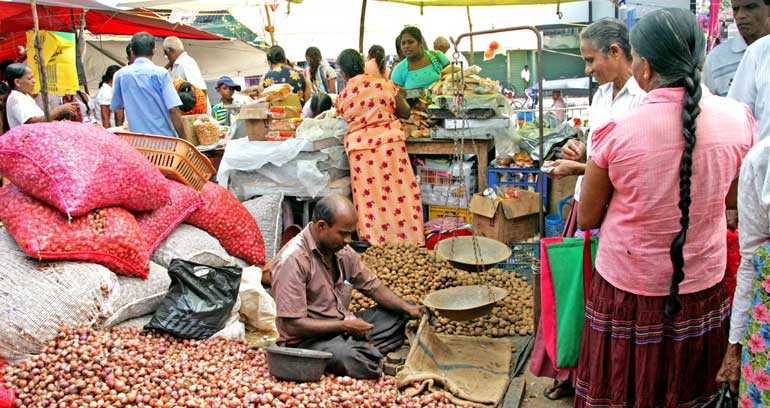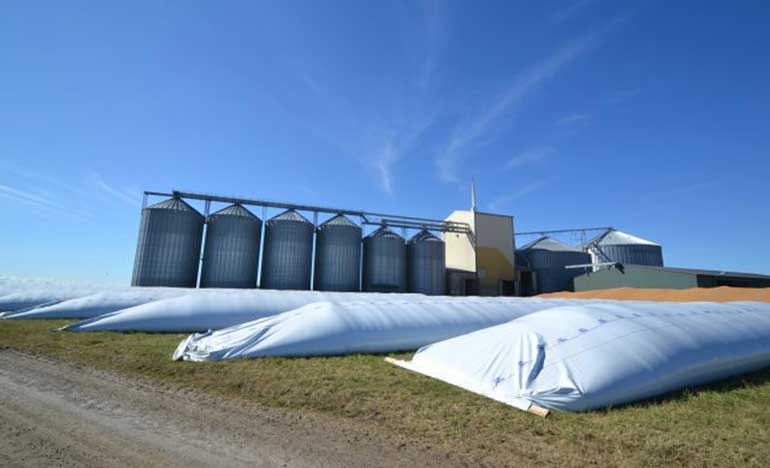Tuesday Mar 04, 2025
Tuesday Mar 04, 2025
Thursday, 24 September 2015 00:00 - - {{hitsCtrl.values.hits}}

The continued postharvest loss scenario needs to be addressed once and for all. A smarter economy is not one which sends fresh produce directly to waste dumps
Dambulla is home to a world heritage site – one of the best preserved cave-temple sites 22 centuries old. It also carries the reputation as a town that never sleeps due to the presence of the economic centre where farm produce change hands to enter into a value chain that finally reaches the consumer or expected as the final destination. 
Farmers bring their produce and receive payments and there are organised mechanisms for these tasks. However, what they receive, when compared to what one pays at retail, is perhaps a sad indictment on their effort. Their earnings to carry on their own lives will only be realised through these sales.
Stories that come out at times from Dambulla and other economic centres should make us pause and think. This is the 21st century and we reside in a country that was once termed as the granary of the east and also considered to be a cradle of the hydraulic civilisation. Yet we have been seriously faltering on this step of food production, harvesting, storage, transport and consumption.
Stories of farmer suicides, street protests after not finding buyers or not getting a satisfactory price for the produce, elephants feeding on piles of produce thrown away in disgust as a result of these failures abound.
Why should we be facing this situation of farm to waste with so much knowledge, research and expertise around? The numbers that circulate as post-harvest losses are significant and they have been maintaining these values for a long period, which is what is puzzling. The percentage that is stated as lost varies from 20% to 50% depending on whether the product is vegetables or fruits. Paddy too is not an exception which also has figures between 10 to 15%.
After much labour and resource expenditure, the produce directly is transformed into waste due to multitude of reasons. Both farmers and consumers suffer and it is believed that the middleman is not affected as their payments have internalised the inevitable losses. The absence of an economic reason as well as lack of broader conscience means that they would not seek a solution as they do not have a problem. It is evident that not all are making losses when you visit Dambulla as the mode of transport for farmers and the businessmen differ significantly.
Leadership required
Leadership is required in attending to this problem as it is a significant drainage on our economy. Many a time the issue of addressing postharvest losses had surfaced. Many a promise has been stated and broken with equal aplomb. What is interesting to note is some fruits even arrive at Dambulla from other countries in a better way.
It is really ironic that we fail to see the obvious, or ask the right questions. The national significance of such losses can only be communicated by assuming leadership for eradication of this problem with the committed goal of national postharvest losses being targeted to be set to an acceptable practical value. Even then the waste still should not be simply wasted.
A COSTI team visiting the site found it quite difficult to find a place that was selling fruit juices though they were all thumbs up for the place once they discovered it. Perhaps they were searching for the wrong type of drink! A reject due to a surface defect need not be directed to a waste pile directly. Processing can come into produce different type of products. Our folklore and rural food practices has many an example of cascading produce to meet needs at different time through different ways.
US example
In the USA, as the economy changed, one of the first tasks had been to eliminate postharvest losses and bringing them under control. The goal was supported by technology with developments in packaging playing a major role. The reduction in losses had resulted in lower food prices to the consumer bringing the cost of living down and with it an increase in the disposable income. That why we may be able to welcome an American farmer to Dambulla as a tourist, whereas the Dambulla farmer has a plethora of issues to simply survive at Dambulla.
John F. Kennedy was especially sympathetic to the cause of the US farmer. It is usually expected that in United States that the farmer should be in a position to receive 50% of the price at retail to his produce as farm gate price. The number in agriculture in US as a percentage is really small. The value stands around 3% of the population and suggests a different type of landownership compared to the Sri Lankan farmer whose plot size undergoes radical change with each generation added to his family. The cultural connotations of agriculture may need revisiting but this is a hard act to enact perhaps. How one can bring about change is an interesting question to answer. Mobile phone may just be the trick!
Storage is key
Current preoccupation with B-onions and paddy too are examples. Interestingly when we have an excellent yield, we face a storage issue. As you are more or less dependent on dry weather to realise drying, varying moisture content too brings in a variety of issues.
Rice is one of the staple grains and the way we handle this grain in storage is quite different to the way wheat is stored in USA. Rice grain is quite happy to absorb moisture and in open storage systems the grain moisture content will eventually equilibrate with the surrounding air. These parameters need to be understood in ensuring proper storage.
The purpose of any grain storage facility is to provide safe storage conditions for the grain in order to prevent grain loss caused by adverse weather, moisture, rodents, birds, insects and micro-organisms. Our storage systems serve as fast food outlets to some species. High relative humidity and high temperatures typical for the humid tropical climate lead to grains absorbing water in storage and to a high final moisture content, definitely not the right recipe for long-term storage.
We appear to plan our way forward with attention paid to ‘let us find some space somewhere’, ‘get money to buy the produce’ as otherwise it is political hara-kiri. All the effort is wasted when the stock that you store is stored in unhygienic and technically imperfect conditions. At some point the space taken up by the Yala season yield is removed to make way for the Maha season yield.
At our ports we try to plan for the right infrastructure to support wheat storage, exact planning for ship to silo, etc., and one will engage with exact details and specifications to ensure that the process is appropriately served. Same is applied with cold storage facilities, etc., for incoming produce. No wonder that what is being shipped from outside arrive at their destination in the appropriate conditions whereas for the local produce the approach is political economics.
It is seen that much of the findings and knowledge reside in reports and the scaling up for solutions do not have champions. While there may be private investors for port-based silo systems, the same is not present for internal mechanised silo systems with proper environmental controls.
Imagine rice milling to take place with excess stocks and rice-based products to enter into the market. Knowing the potential production, rice flour pathway could be immediately exploited. It is sad that our line of thinking is paddy must be stored as paddy and bread must come out of wheat flour. These are issues that deliver unhealthy balance of trade. As long as some fresh thinking is not in place, the balance is always going to be against us and our systems will not be envied by anybody.
While we speak of enhanced production to meet the growing demand, we appear only to seek extra production without addressing any waste issues. All the inputs are managed, supported and subsidies handed out too with religious fervour and much fanfare only to see few months later the garbage heaps receiving stocks straight from the farm!
The continued postharvest loss scenario needs to be addressed once and for all. A smarter economy is not one which sends fresh produce directly to waste dumps. It is important to address all inefficiencies while on the way to a smarter economy. This is an inefficiency that demands immediate and urgent attention as it is an indictment of our methods and systems if we continue to accept and perpetuate the present situation.
[The writer is Professor of Chemical and Process Engineering at the University of Moratuwa, Sri Lanka. With an initial BSc Chemical engineering Honours degree from Moratuwa, he proceeded to the University of Cambridge for his PhD. He is the Project Director of COSTI (Coordinating Secretariat for Science, Technology and Innovation), which is a newly established State entity with the mandate of coordinating and monitoring scientific affairs. He can be reached via email on [email protected].]
 Storage of grain and other crops in this silo ‘grain saver’ system is a cost-effective, flexible and mobile solution. The storage system was originally developed in Argentina some 10 years ago and has since spread throughout the world
Storage of grain and other crops in this silo ‘grain saver’ system is a cost-effective, flexible and mobile solution. The storage system was originally developed in Argentina some 10 years ago and has since spread throughout the world
Discover Kapruka, the leading online shopping platform in Sri Lanka, where you can conveniently send Gifts and Flowers to your loved ones for any event including Valentine ’s Day. Explore a wide range of popular Shopping Categories on Kapruka, including Toys, Groceries, Electronics, Birthday Cakes, Fruits, Chocolates, Flower Bouquets, Clothing, Watches, Lingerie, Gift Sets and Jewellery. Also if you’re interested in selling with Kapruka, Partner Central by Kapruka is the best solution to start with. Moreover, through Kapruka Global Shop, you can also enjoy the convenience of purchasing products from renowned platforms like Amazon and eBay and have them delivered to Sri Lanka.
Discover Kapruka, the leading online shopping platform in Sri Lanka, where you can conveniently send Gifts and Flowers to your loved ones for any event including Valentine ’s Day. Explore a wide range of popular Shopping Categories on Kapruka, including Toys, Groceries, Electronics, Birthday Cakes, Fruits, Chocolates, Flower Bouquets, Clothing, Watches, Lingerie, Gift Sets and Jewellery. Also if you’re interested in selling with Kapruka, Partner Central by Kapruka is the best solution to start with. Moreover, through Kapruka Global Shop, you can also enjoy the convenience of purchasing products from renowned platforms like Amazon and eBay and have them delivered to Sri Lanka.